Heading to America: Tadano’s 100 ton all electric EVOLT RT
10 September 2024
The Tadano EVOLT is the first electric rough terrain crane designed to work in North America. D.Ann Shiffler reports exclusively from Shido, Japan.
With the skies threatening a summer shower, Tadano’s product development team at the Shido manufacturing facility in Shido, Japan, was excited to show off the Tadano EVOLT eGR-1000XLL-1. ACT was onsite exclusively in early July to see the new battery-electric crane that was amid final testing before shipping out to North America.
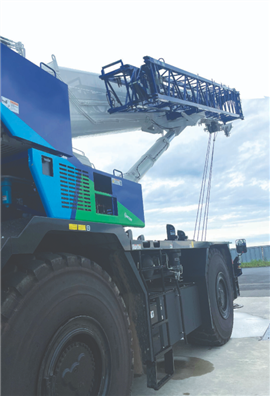 Tadano’s new 100 US ton capacity battery operated EVOLT eGR-1000XLL-1 is set for North American distribution.
Tadano’s new 100 US ton capacity battery operated EVOLT eGR-1000XLL-1 is set for North American distribution.
The prototype and production models of the new 100-US ton (90 metric ton) capacity rough terrain crane have been put through the paces, undergoing rigorous testing on every system. Several elements of the crane were upgraded, most notably a change in the charging system to 480 Volt AC.
“We are very confident in the investment we’ve made in this crane,” said Dean Barley, President and CEO at Tadano America. “This crane has been tested and retested. We wanted to make sure that the first fully electric rough terrain crane in North America meets all the requirements of the market.”
The product demonstration began with the start up of a Tadano GR-1000XLL-4, a diesel-powered RT that has enjoyed strong success worldwide. The operator drove the 100-ton capacity crane up and down the demonstration area and then set the crane’s outriggers to perform boom maneuvers. The crane operated seamlessly.
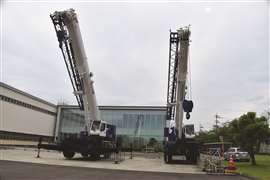 At the Shido Plant in Japan, a diesel-powered Tadano GR-1000XLL-4 and the new electric EVOLT eGR-1000XLL-1 were demonstrated side by side. The only difference in the operation of the two cranes is that the EVOLT is emissions free and it operates silently.
At the Shido Plant in Japan, a diesel-powered Tadano GR-1000XLL-4 and the new electric EVOLT eGR-1000XLL-1 were demonstrated side by side. The only difference in the operation of the two cranes is that the EVOLT is emissions free and it operates silently.
Silent operation
Next, the EVOLT eGR-1000XLL-1 was started up, without a sound. The operator took the EVOLT through the same maneuvers as the GR-1000XLL-4, with one noticeable difference. The EVOLT operated silently. The only discernible noise was when the boom hydraulics were engaged.
“Aside from the EVOLT operating silently, these cranes are virtually the same except for their power source,” Barley said. “And of course the EVOLT is emissions free.”
The product development team’s attention to every detail was immensely important to Barley, who expects the EVOLT to quickly gain acceptance in North America. The EVOLT operates on battery power for at least five hours and has a travel distance of 5.5 miles (9 km). Depending on the application, the crane can operate for up to seven hours before traveling back to its charging station.
After watching the crane operate, we visited various areas of the Shido Plant, including the Low Temperature Test Facility and the Power Train Test Facility.
“It was important to make sure this crane could operate in severe conditions, in heat and in frigid areas like Canada, where our RTs are very popular,” Barley said.
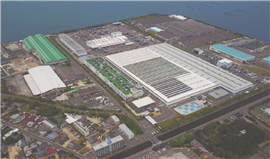 Tadano’s 200,000-square-meter ocean-side Shido Manufacturing Facility was built in 1980. Rough terrain and all-terrain cranes are produced at Shido.
Tadano’s 200,000-square-meter ocean-side Shido Manufacturing Facility was built in 1980. Rough terrain and all-terrain cranes are produced at Shido.
Much attention was paid to the battery and charging system. The crane features a DC fast Type CCS1 charging system with a maximum power output of 150 kW. The onboard AC charging system is a 480 Volt AC (3-phase) system. Full fast recharging takes about two hours. Using the 480 Volt AC normal charger takes 4.5 to 5.5 hours on its highest 40 kW setting. Under normal usage conditions, the batteries are expected to have a useful life of between eight and ten years.
Another encouraging element of Tadano’s Green Solutions initiative is that the company has been producing an electric crane for the Japanese market. Tadano now has vital experience rolling out a fully electric product, and the product development team understands all the nuances. The Tadano EVOLT eGR-250N-1 has been working the Japanese market since 2023.
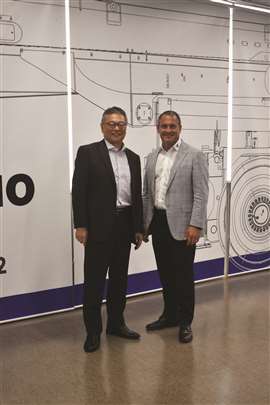 Together at the Kozai manufacturing facility in Japan are Toshiaki Ujiie, Tadano President and CEO, and Dean Barley, President and CEO, Tadano America.
Together at the Kozai manufacturing facility in Japan are Toshiaki Ujiie, Tadano President and CEO, and Dean Barley, President and CEO, Tadano America.
Cost of operation
Cost of operation was a huge consideration for the EVOLT, which will cost a little more than its diesel counterpart. But the operational savings can quickly make up for the cost, Barley said.
Tadano has created operating cost comparisons for the two cranes, and the results are impressive. On an annual basis, Tadano estimates the operating costs of the EVOLT will be about 35 per cent less than the diesel machine. Fuel or electricity and maintenance costs were considered based on 1,200 operating hours a year.
“Beyond the annual operations cost savings, the EVOLT reduces carbon emissions by 49,000 pounds [22 metric tons],” Barley said. “Customers in North America are excited about this crane.”
He said the quiet operation of the EVOLT will be a major selling point, and will be an asset working at night near hospitals and residential areas. Advancing decarbonization and “green solutions” is an important company initiative, Tadano President and CEO Toshiaki Ujiie said.
“We have decarbonization goals for 2030 and to 2050,” he said. “We have an aggressive plan to produce electric and hybrid product lines. We will continue to give our customers green choices.”
EVOLT specs
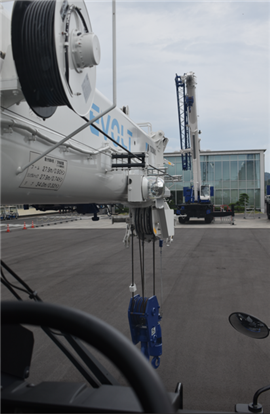
Tadano said the plan for the EVOLT was to use electric motors for the driveline and to power the hydraulic pumps, while the hydraulic system for the crane functions remains the same with the same performance characteristics as the diesel model.
Boom length: 42 to 167 feet 4 inches (12.8 to 51 metres)
Jib length: 33 feet 2 inches or 58 feet 1 inch (10 to 17.7 metres)
Maximum lifting capacity: 100 tons at 8 feet radius (90.7 tonnes @ 2.4 metres radius)
Maximum working radius: 155 feet (47 metres)
Length: 49 feet 8 inches (15.1 metres)
Width: 10 feet 10.5 inches (3.1 metres)
Height: 12 feet 3 inches (3.7 metres)
Travel speed: 11 mph (18 km/h)
Weight (base machine): 129,000 pounds (58.5 tonnes)
Operating time: 5 hours (depending on application up to 7 hours)
Travel range (only travel): 16 miles (26 km)
Normal charging: 480 Volt AC 3-phase, 40 kW
Fast charging: US COMBO CCS1, 150 kW



